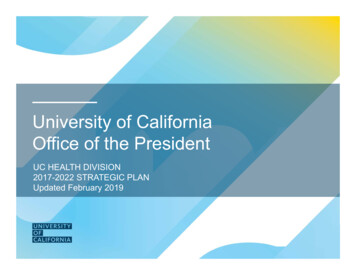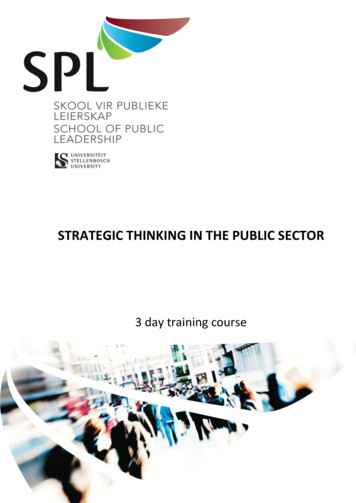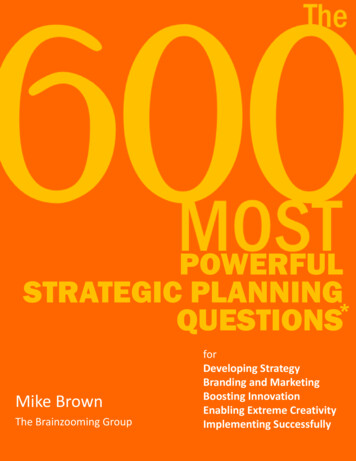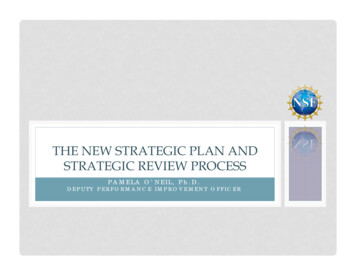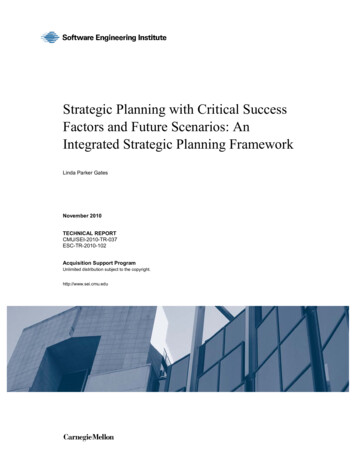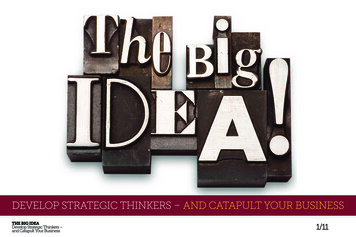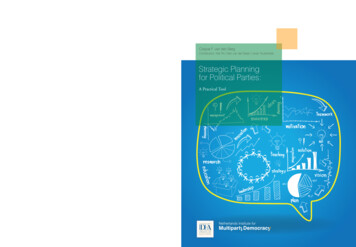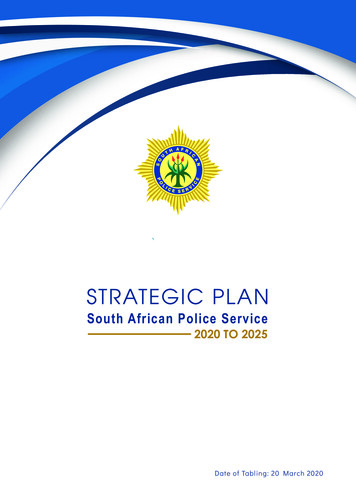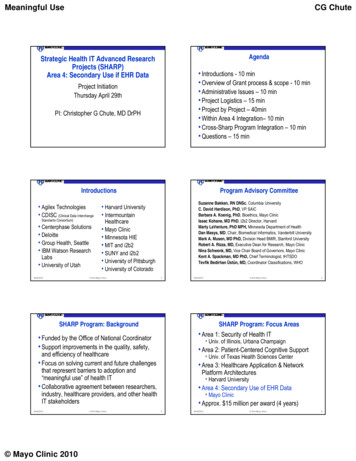
Transcription
Meaningful UseCG ChuteAgendaStrategic Health IT Advanced ResearchProjects (SHARP)Area 4: Secondary Use if EHR Data Introductions - 10 min Overview of Grant process & scope - 10 min Administrative Issues – 10 min Project Logistics – 15 min Project by Project – 40min Within Area 4 Integration– 10 min Cross-Sharp Program Integration – 10 min Questions – 15 minProject InitiationThursday April 29thPI: Christopher G Chute, MD DrPHIntroductions Agilex Technologies CDISC (Clinical Data InterchangeStandards Consortium) Centerphase Solutions Deloitte Group Health, Seattle IBM Watson ResearchLabs University of Utah04/28/2010Program Advisory CommitteeSuzanne Bakken, RN DNSc, Columbia UniversityC. David Hardison, PhD, VP SAICBarbara A. Koenig, PhD, Bioethics, Mayo ClinicIssac Kohane, MD PhD, i2b2 Director, HarvardMarty LaVenture, PhD MPH, Minnesota Department of HealthDan Masys, MD, Chair, Biomedical Informatics, Vanderbilt UniversityMark A. Musen, MD PhD, Division Head BMIR, Stanford UniversityRobert A. Rizza, MD, Executive Dean for Research, Mayo ClinicNina Schwenk, MD, Vice Chair Board of Governors, Mayo ClinicKent A. Spackman, MD PhD, Chief Terminologist, IHTSDOTevfik Bedirhan Üstün, MD, Coordinator Classifications, WHO Harvard University IntermountainHealthcare Mayo Clinic Minnesota HIE MIT and i2b2 SUNY and i2b2 University of Pittsburgh University of Colorado 2010 Mayo Clinic304/28/2010SHARP Program: Background Area 1: Security of Health IT Univ. of Illinois, Urbana Champaign Area 2: Patient-Centered Cognitive Support Univ. of Texas Health Sciences Center Area 3: Healthcare Application & NetworkPlatform Architectures Harvard University Area 4: Secondary Use of EHR Data Mayo Clinic Approx. 15 million per award (4 years)and efficiency of healthcare Focus on solving current and future challengesthat represent barriers to adoption and“meaningful use” of health IT Collaborative agreement between researchers,industry, healthcare providers, and other healthIT stakeholders Mayo Clinic 2010 2010 Mayo Clinic4SHARP Program: Focus Areas Funded by the Office of National Coordinator Support improvements in the quality, safety,04/28/2010 2010 Mayo Clinic504/28/2010 2010 Mayo Clinic6
Meaningful UseCG ChuteSecondary Use of EHR Data: Themes & ProjectsSecondary Use of EHR Data: Research Areas Retrospectively and prospectively creating “insilico” cohorts of study controls Approaches for the implementation of study andmeasures inclusion and exclusion criteria Methods for stratifying patients across categoriesof risk, demographics and care treatments Strategies, heuristics and methods tocompensate for inconsistent and incomplete data Creating structured data from unstructured datausing NLP to identify outcomes04/28/2010 2010 Mayo Clinic704/28/2010 2010 Mayo ClinicAdministrative IssuesProgram/Project Management Budget Closures Final Budget & Budget Justifications dueTODAY to Michelle Kvall/Jeremy Eckhoff Contract Process8SitesCentralized Area 4ProgramManagementProj, TeamsStakeholders Starting May 3, contract officer will be in contactDr. Chris Chute, PILacey Hart, Program ManagerONCPACProj. LeadsSupport program/projects/sites, coordinate activities and logistics, facilitatecommunications, and information sharing, and maintain records Project Management Roles Mayo Clinic – serve as coordinating center &Cindy Bandel,Associate Proj. MgrJay DoughtyProj. MgrDeloitteFinance /Post Award Deloitte – face-to-face facilitationAdministrative andlogistic support(web support)NLP ProjectSupportF2F Facilitation &ConsultationContractsFinancial MgtReportingproject specific task/resource managementArea 4: More information Logistics June 21/22 F2F Technology Infrastructure Project Lead Calls Project Team Telecons PAC role/schedule Quarterly Reports Semi-annual Reports Science & 10 Mayo Clinic 2010 2010 Mayo Clinic12
Meaningful UseCG ChuteClinical Data NormalizationDr. ChuteAims: Build generalizable data normalization pipeline Semantic normalization annotators involvingLexEVS Establish a globally available resource forhealth terminologies and value sets Establish and expand modular library ofnormalization algorithmsProject 2: Clinical NaturalLanguage Processing (cNLP)29th April, 2010Guergana Savova, PhDProject II: Clinical Natural LanguageProcessing (cNLP)Integration of Information Overarching goal High-throughput phenotype extraction fromclinical free text based on standards and theprinciple of interoperability Focus Information extraction (IE): transformation ofunstructured text into structured representations Merging clinical data extracted from free text withstructured dataNational Health Information Infrastructure meeting, 2003Data Normalization Informed by Project I University of Utah’s models for episodes ofcare (www.clinicalelement.com) Series of encounters between patient and healthcare system during which a problem is addressed(complaints, diagnoses, lab results, chronicmedical problems, associated symptoms,physical examination findings, treatment plans). Detailed clinical data for each episodeData Normalization (cntd.) College of American Pathologists (CAP) cancerprotocols Example: colon cancer template – procedure,tumor site, size, histology, grade, tumor extension,margins, lymph nodes Medication profile (RxNORM) Medication, dosage, route, frequency, form,strength Other standards: LOINC, SNOMED-CT, NDFRT, CPT-4 Mayo Clinic 2010
Meaningful UseCG ChutePhenotypingcNLP Specific Aim 1 Clinical concept and event discovery from the clinical Project IIInarrative(1) defining a set of clinical events and a set of attributes to bediscovered(2) identifying standards to serve as templates for attribute/valuepairs(3) creating a "gold standard" through the development ofannotation schema, guidelines, and annotation flow, andevaluating the quality of the gold standard(4) identifying relevant controlled vocabularies and ontologies forbroad clinical event coverage(5) methodological support for a broad array of clinical eventdiscovery and template population(6) extending Mayo Clinic's clinical Text Analysis and KnowledgeExtraction System (cTAKES) information model, andimplementing best-practice solutions for clinical event discovery. Common grammar that can represent the formalsyntax and semantics of the phenotype extractionalgorithms in the form of constraint statements withappropriate boolean and logic operations "operation to remove an ovary using a laser:"83152002 oophorectomy :260686004 method 257820006 laser excision-action , where83152002, 260686004, and 257820006 are SNOMED-CTconcept identifiers.cNLP Specific Aim 2 Relation discovery among the clinical events discovered inAim 1(1) defining a set of relevant relations(2) identifying standards-based information models for templatednormalization(3) creating a gold standard through the development of anannotation schema, guidelines, and annotation flow, and evaluatingthe quality of the gold standard(4) developing and evaluating methods for relation discovery andtemplate population(5) implementing high-throughput scalable phenotype extractionsolutions as annotators in cTAKES and UIMA-AS, either within aninstitution’s local network or as a cloud-based deploymentintegrated with the institution’s virtual private network.Project II Investigators David Carrell, Seattle Group Health Wendy Chapman, University of Pittsburgh Peter Haug, University of Utah Jim Martin, University of Colorado Martha Palmer, University of Colorado Guergana Savova, Childrens Hospital Boston Peter Szolovits, MIT Wayne Ward, University of Colorado Ozlem Uzuner, University of AlbanyThe Big Question Project 3: High-Throughput Phenotyping The era of Genome-Wide Association Studies(GWAS) has arrived Genotyping cost is asymptoting to free [Altman et29thal.]April, 2010Jyoti Pathak, PhDAssistant Professor of Biomedical InformaticsDepartment of Health Sciences Research Most (all?) published GWAS are done on carefullyselected and uniformly characterized patientpopulations How “good” are EMRs (with inconsistencies andbiases) as a source of phenotype?04/29/10 Mayo Clinic 2010 2010 Mayo Clinic24
Meaningful UseCG ChuteEMR-based Phenotype AlgorithmsEMR-based Phenotype Algorithms Typical components Billing and diagnoses codes Procedure codes Labs Medications Phenotype-specific co-variates (e.g., Demographics,Vitals, Smoking Status, CASI scores) Organized into inclusion and exclusion criteria04/29/10 2010 Mayo Clinic25 Iteratively refine case definitions through partialmanual review to achieve PPV 95%) For controls, exclude all potentially overlappingsyndromes and possible matches; iterativelyrefine such that NPV 98%04/29/10Example: Type 2 Diabetes (cases)04/29/10 2010 Mayo Clinic 2010 Mayo Clinic26ICD-9-CM codes for Type 2 Diabetes2704/29/10Prescribed Medications for Type 2 Diabetes 2010 Mayo Clinic28Example: Type 2 Diabetes (Controls) Have not been assigned ICD-9 codes for diabetesor diabetes-related condition Not prescribed insulin, pramlintide, or any diabeticmedications or supplies Has a reported glucose and it is 110 mg/dl No reported hemoglobin A1C 6.0% No reported family history of T2D04/29/10 Mayo Clinic 2010 2010 Mayo Clinic2904/29/10 2010 Mayo Clinic30
Meaningful UseCG ChuteChallengesSemi-automatic Cohort Identification Algorithm design Non-trivial; requires significant expert involvement Highly iterative process Time-consuming manual chart reviews Representation of “phenotypic logic” Data access and representation Lack of unified vocabularies, data elements, and valuesets Questionable reliability of ICD & CPT codes (e,g., omitcodes that don’t pay well, billing the wrong code since itis easier to find) Natural Language Processing needs And many more 04/29/10 2010 Mayo Clinic31Project 3: Collaborators04/29/10 2010 Mayo ClinicUIMA exploitationMarshall Schor – IBM Research Use UIMA as a unifying framework, leveraging ecosystem CDISC (Clinical Data Interchange Standards Work with team leads to identify “fit” (or not) of UIMA intoConsortium) Centerphase Solutions IBM Watson Research Labs Intermountain Healthcare Mayo Clinic University of Utahsubprojects Phenotyping and Data Quality, especially Support UIMA and UIMA-AS use Do UIMA-101 webinar or ? for other teams Consult on pipe line design / architectures / configuration Support scaling, capacity flexibility Develop and deploy virtual machine images that can dynamicallyscale in cloud computing environments Develop integration / deployment tooling with goal of simplicity Enabling widespread adoption of POC04/29/10 2010 Mayo ClinicData QualityDr. BaileyAims: Refine metrics for data consistency Deploy methods for missing or conflicting dataresolution Integrate methods into UIMA pipelines Refine and enhance methods33Real-world evaluation frameworkDr. Huff We will iteratively test our normalizationpipelines, including NLP where appropriate,against these normalized forms, and tabulatediscordance. Normalize retrospective data from the EMRs andcompare it to normalized data that already existsin our data warehouses (Mayo Enterprise DataTrust). Use cohort identification algorithms in both EMRdata and EDW data. Normalize the data against CEMs. Mayo Clinic 201032
Meaningful UseCG ChuteReal-world evaluation framework Integrating normalization and phenotyping algorithmsinto HIE data flows and NHIN Connect linkages; Validate data sent to or received from the UHIN network against CEM modelsUse CEM models as the definition of payloads withinNHIN Connect service callsUse of NLP on document payloads that are already inuse?Questions Data is not actually flowing in Utah yet. What is the status inMinnesota? Who is communicating? Where should we try this out? Is NHIN Connect in actual use in Minnesota’s HIE?Real-world evaluation framework Cohort identification for translational scienceprotocols; Data that is submitted to the FURTHeR database wouldbe verified against CEM definitions. Can we use NHIN Connect as the mechanism for Other questions What disease cohort(s) should we use? What database exists in Mayo’s CTSA? Timing: Is data actually flowing in Utah’s & Mayo’s dbs?Area 4 Integration Project Lead Teleconferences Face to Face Transparent / centralized documentation Project management supportQuestions Mayo Clinic 2010querying data in FURTHeR? If so, we can use CEMs asthe logical definition of data being addressed in the query.Can we execute Cohort Amplification against theFURTHeR database?Accuracy will be measured against the original EHR dataCross-Sharp Program Integration PI Face to Face Yearly Jamboree w/Area Leads (rotating host) Potential for cross integration telecons Documentation transparency Sharps.org – Area 1Sharpc.org – Area 2TBD – Area 3Informatics.mayo.edu/sharp – Area 4 (sharp’n)
Nina Schwenk, MD, Vice Chair Board of Governors, Mayo Clinic Kent A. Spackman, MD PhD, Chief Terminologist, IHTSDO . Mayo Clinic - serve as coordinating center & . manual review to achieve PPV 95%)
